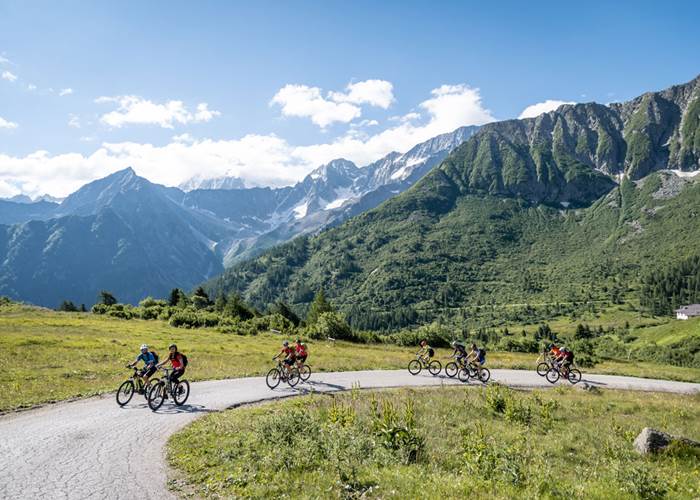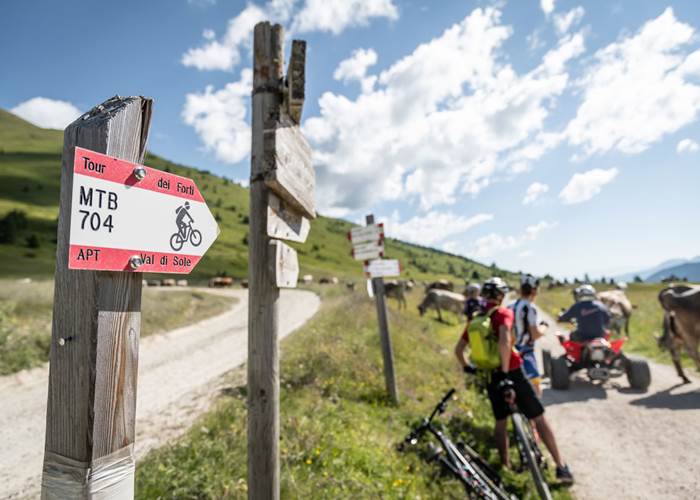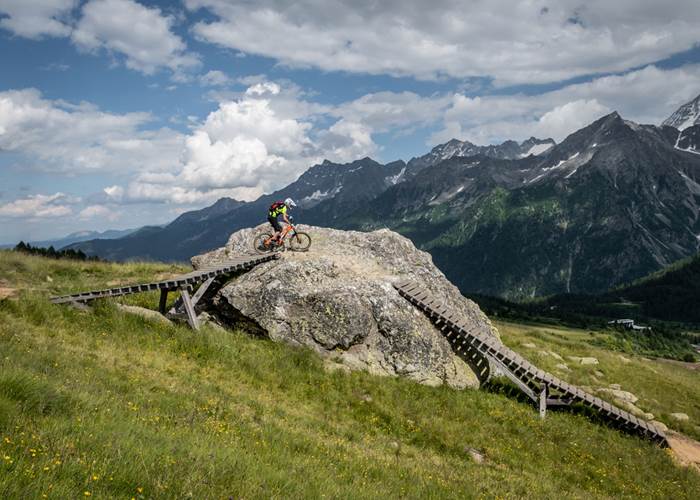GAVIA, MORTIROLO, PASSO TONALE BY BIKE: DISCOVER THE GREAT CLASSICS
What does it mean to climb the Mortirolo Pass by bike? Or the Gavia, or the Tonale Pass? It means conquering the great climbs that have made the Giro d'Italia legendary. The Pontedilegno-Tonale area has always been the scene of the unforgettable exploits of the greatest international cycling champions, from Fausto Coppi and Gino Bartali to Marco Pantani and Miguel Indurain, from Ivan Basso and Gilberto Simoni up to today's golden names.
Challenging routes through breathtaking landscapes that test the skills of even the most experienced bikers: these climbs are a must-do for all road riders!
- The most famous climbs in Italy
- Itineraries for all levels: from beginners to professionals
- Breathtaking views
- Possibility of renting, purchasing, maintaining and storing bikes
The legend of road biking between Ponte di Legno and Passo Tonale

Steep descents and ascents: the roads of the Pontedilegno-Tonale bike area seem made especially for racing bike lovers. Routes for all tastes and all levels, immersed in breathtaking views overlooking the most beautiful mountains in Europe. Here are the most famous ones.
PASSO GAVIA FROM PONTE DI LEGNO
One of the most historical climbs associated with the Giro d’Italia and which, since 1960, was a challenge to some of the world’s best cyclists.
The climb starts at the bridge over the Frigidolfo creek and gets to Sant’Apollonia after the first km of slight slope. The climb then reaches a 14% gradient and, winding up towards the Passo, there are panoramic views on the Valle Camonica and the Adamello glaciers. When out of the wood, you proceed with a less demanding gradient and then reach a 400m long tunnel, which is lit only on one side (please make sure that you have your own additional light). The ascent becomes once again very steep and after the last hairpin bends, where you can see the Lago Nero from above, the road in the very last part becomes almost flat as you arrive at Passo Gavia at 2.652 m.
FUN FACT
This course was discovered by chance in 1960 thanks to the patron of the Giro d’Italia, Vincenzo Torriani, who, after having caught sight of the climb during an aerial survey, decided to add it to the Giro. The most famous event took place on the 5th June 1988, the cyclists had to deal with snow and ice right from the start and some of them were given first aid because of freezing symptoms while others arrived at the finish line beyond the maximum time.
PASSO MORTIROLO FROM MONNO
This ascent was introduced in the Giro d’Italia for the first time in 1990.
This ascent starts at the junction with the SS42, direction Monno. After the first ascent that leads to Monno, you ride through the village and along wide meadows in slight slope. After the creek Palù the situation changes, there are many hairpin bends and the gradient becomes more demanding. The road winds up across the wood. Out of the wood there are 2 more km to the Passo; a first flat part and then the last steep part, the most demanding of the whole ascent, with very narrow hairpin bends and a maximum gradient of 16,9%. You get to Passo Mortirolo at 1.852 after the junction with the three roads leading to Monno, Trivigno and Mazzo di Valtellina.
FUN FACT
During the Giro d’Italia of 1994, a 24-year-old cyclist began riding bend after bend and creating a void behind him, until he reached the finish line 2,52 minutes ahead the cyclist that followed. This young cyclist at that time was almost unknown, his name is Marco Pantani. In 2006 a monument in memory of this legendary cyclist was erected on the Valtellina side of the pass.
Fu percorso per la prima volta dal Giro d’Italia nel 1990.
PASSO TONALE FROM FUCINE DI OSSANA
This route was first part of the Giro d’Italia in 1933 in the stage Bolzano-Milano and is listed in the ‘Grandi Salite del Trentino’.
The climb starts on the SS42 at the junction to Pejo at the village of Fucine (which is part of Ossana). Until the village of Vermiglio you keep climbing in a regular way, then the gradient gets steeper. The valley becomes more narrow and characterized by woods. After 9 km you can see Forte Strino, dating back to the 1st world war. The climb becomes more demanding for 1 km with a 9,9% gradient. Things get better in the last km, the road is not so steep and you have a panoramic view on the Presanella glacier; in a few minutes you get to the military shrine at Passo Tonale.
FUN FACT
In 1939 this route became crucial to the Giro d’Italia. Gino Bartali, who was the favourite to win the race, lost the stage and consequently the entire Giro d’Italia to Valetti, due to the bad weather conditions (snow and fog). As he always did, Bartali had checked the weather forecast beforehand, but this didn’t help avoid the accident and the defeat.
PASSO TONALE FROM PONTE DI LEGNO
The ascent to Passo Tonale from the Valle Camonica was first introduced in the Giro d’Italia in 1981.
The climb starts as a slight slope from the SS42 at the junction to Ponte di Legno centre. After the first hairpin bend of the Val Sozzine the road starts with 6% gradient and panoramic views on mount Castellaccio and Ponte di Legno from above. You reach a place called Tonalina where you can see the Pisgana valley and the beautiful mountains of the Adamello group. The gradient becomes more demanding (up to 12%) for the following 12 km, then it turns better along summer pastures. The road for the last km becomes straight until you get sight of the Passo Tonale and its military shrine.
FUN FACT
In 1984 the cyclists of the 67th Giro d’Italia arrived at Passo Tonale from Valle Camonica. The route was meant to pass through Passo dello Stelvio but due to heavy snowfalls it was decided to have Passo Tonale and Passo Palade instead, with the finish line in Merano. This decision was very controversial and people complained insisting it was in order to favour Francesco Moser.
Mortirolo by bike: challenge the champions!
Passo Mortirolo is one of the hardest climbs in the Giro d'Italia, and is in fact one of the few timed climbs in the race. In the various editions the champions have set ever lower record times: now you too can compete with the top riders and why not... try to beat them!


